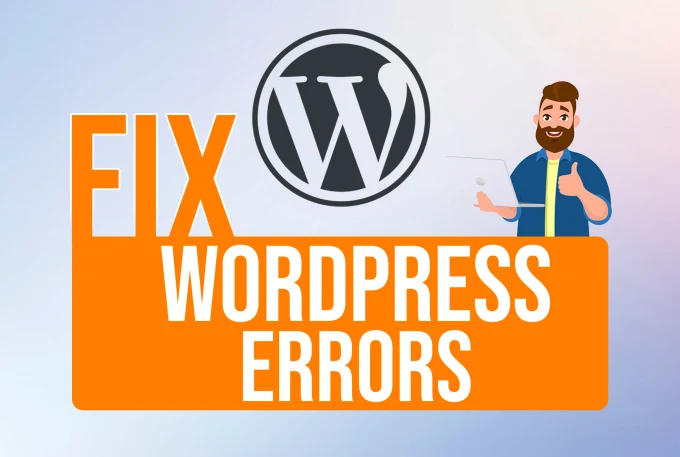WordPress is one of the most popular content management systems (CMS) for building websites, thanks to its user-friendly interface and extensive customization options. However, like any platform, WordPress isn’t immune to issues. Whether you’re a beginner or an experienced developer, you may encounter various problems while managing a WordPress website. This blog will explore some of the most common WordPress website issues and provide solutions to resolve them.
1. Slow Website Speed
Issue: A slow website can drive away users and negatively impact your SEO. WordPress sites, especially those with many plugins or heavy themes, can become sluggish.
Solution:
- Optimize Images: Compress and resize images before uploading them to your site. Use plugins like Smush or EWWW Image Optimizer for automatic compression.
- Enable Caching: Use a caching plugin like W3 Total Cache or WP Rocket to store static versions of your site and serve them to users, improving load times.
- Use a Content Delivery Network (CDN): CDNs store your website’s files across multiple locations worldwide, reducing the distance between your server and the user. Cloudflare and StackPath are great options.
- Minimize Plugins: Deactivate and delete any plugins you don’t use or that are resource-heavy.
2. White Screen of Death (WSOD)
Issue: One of the most frustrating WordPress issues is when your website displays a blank white screen, often referred to as the “White Screen of Death.”
Solution:
- Disable Plugins: WSOD often occurs due to conflicting or poorly coded plugins. Access your website via FTP or cPanel, go to
wp-content/plugins, and rename the plugins folder. This will deactivate all plugins. Then, activate them one by one to find the culprit. - Switch to a Default Theme: If the issue is theme-related, switch to a default theme (like Twenty Twenty-One) via your WordPress dashboard or by renaming your current theme folder.
- Increase PHP Memory Limit: Your site might be running out of memory. To fix this, increase the PHP memory limit by editing the
wp-config.phpfile and adding the following line:define( 'WP_MEMORY_LIMIT', '256M' );
3. 404 Errors
Issue: A 404 error occurs when a user tries to visit a page that doesn’t exist. This can frustrate users and affect your search engine rankings.
Solution:
- Check Permalinks: Go to Settings > Permalinks and click the “Save Changes” button to refresh your site’s permalink structure.
- Create Redirects: Use a plugin like Redirection to redirect any broken or outdated URLs to the correct pages.
- Check .htaccess File: The issue may also lie in your
.htaccessfile. You can regenerate it by saving your permalinks settings or manually checking the code for issues.
4. WordPress Keeps Logging Out
Issue: WordPress logging you out frequently can be annoying and disrupt your workflow.
Solution:
Clear Browser Cookies: WordPress uses cookies to track login sessions, and old cookies can cause issues. Clear your browser’s cookies and cache.
Correct Site URL: Ensure your site and WordPress URLs match. Go to Settings > General and check that the WordPress Address (URL) and Site Address (URL) are the same.
Check the Cookie Path: If the problem persists, add the following lines to your wp-config.php file:
define( 'COOKIE_DOMAIN', '' ); define( 'COOKIEPATH', '/' );
5. Error Establishing a Database Connection
Issue: This error typically occurs when WordPress is unable to connect to the database. It can happen due to incorrect database credentials, a corrupted database, or server issues.
Solution:
Check Database Credentials: Open your wp-config.php file and ensure that the database name, username, password, and host are correct.
Repair the Database: Add the following line to your wp-config.php file to initiate the database repair feature:
define( 'WP_ALLOW_REPAIR', true );
After that, visit www.yourwebsite.com/wp-admin/maint/repair.php to repair the database.
Contact Your Host: If neither of these solutions works, contact your web hosting provider to check if there’s a server issue.
6. Plugin Conflicts
Issue: Sometimes, two or more plugins conflict with each other, causing your website to break or function improperly.
Solution:
- Disable Plugins: As with WSOD, deactivate all plugins and reactivate them one by one to identify the problematic plugin.
- Use a Staging Site: Test plugin updates or new installations on a staging site before applying changes to your live site.
7. Memory Exhausted Error
Issue: This error occurs when WordPress consumes all the allocated server memory. You might see an error message like “Allowed memory size of X bytes exhausted.”
Solution:
Increase Memory Limit: Edit the wp-config.php file and increase the memory limit by adding:
define( 'WP_MEMORY_LIMIT', '256M' );
Optimize Plugins and Themes: Deactivate heavy plugins or switch to a lighter theme to reduce memory usage.
8. Broken Links
Issue: Over time, links within your WordPress content might break due to URL changes or content deletion. Broken links negatively impact SEO and user experience.
Solution:
- Use a Broken Link Checker Plugin: Install and use the Broken Link Checker plugin to detect and fix broken links.
- Regularly Update Links: Regularly check your content and update any outdated URLs.
9. WordPress Site Is Not Secure
Issue: Many WordPress websites are vulnerable to security threats, including hacks and malware, especially if they’re not maintained properly.
Solution:
- Install a Security Plugin: Use a security plugin like Wordfence or iThemes Security to protect your site from vulnerabilities.
- Keep WordPress Updated: Always update WordPress, themes, and plugins to their latest versions to prevent security issues.
- Use Strong Passwords and Two-Factor Authentication (2FA): Ensure all users have strong passwords and enable 2FA for added security.
Final Thoughts
While WordPress is an excellent platform for building websites, it’s important to stay proactive about addressing common issues. By following the troubleshooting tips outlined above, you can ensure your website remains fast, secure, and user-friendly. Regular updates, backups, and website audits will go a long way in preventing and resolving WordPress-related issues, allowing you to focus on growing your online presence.
If you encounter persistent issues that you can’t solve, don’t hesitate to seek professional assistance to ensure your website runs smoothly.
